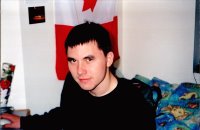The polls in Canada are open, but there is a ban on the media reporting any results until they close in the Yukon and British Columbia: eight time zones away. By the time that happens, at 3:00am tonight, I should already be asleep, with a superb essay for Dr. Hurrell printed and consigned to a neatly labeled envelope.
In short, I am looking for any interesting information from people back home: electoral predictions, observations, celebrations, lamentations – whatever you care to share.
The only personal message that I want to send to people in Canada is to take the trouble to get out and vote. This applies especially to friends of mine. While I know that most of you are going to vote anyhow, it’s worth remembering that the turnout among young voters is just abysmal. Regardless of the outcome, this election is going to change the course of Canadian politics. As such, it seems like a basic democratic responsibility to contribute.
[Update: 6:37pm GMT] As a Canadian citizen running a blog from outside Canada that isn’t hosted inside Canada, I am pretty sure I can report whatever I want – regardless of media blackout laws. While I don’t have any early polling results on hand, here is my personal electoral prediction:
Liberal: 94-96
Conservative: 125-128
New Democrat: 28-33
Bloc: 53-57
Independent: 1
The total number of seats in the House of Commons is 308, so a majority would be 154.
[Update 11:36pm GMT] As I understand the closing of polls and the time zones:
Polls in Newfoundland close in fifteen minutes.
Polls in Atlantic Canada close in just under an hour.
Polls in Ontario and Quebec close in three hours.
Polls in British Columbia close in three and a half hours.
Exciting stuff, but no results yet.
[Update 12:23am GMT] Regardless of your political stance, this is an exciting night. The Liberals have been in power since I was ten years old: more than half of my life. All signs indicate that Canada will have a new Prime Minister tomorrow. What’s this going to mean? It’s a question that feels much more pressing than that of whether world war one confirmed or refuted liberal theory: the topic of tomorrow morning’s seminar.
[Update 12:47am GMT] For the moment, at least, it seems that both ProAlberta and Captain’s Quarters (blogs that had declared an intention to publish polling results as they come in) have been overwhelmed by the number of people attempting to access them.
This probably marks the high point in worldwide interest in Newfoundland for at least the last couple of years.
[Update: 2:06am GMT] People have been posting numbers in the comments which, as I understand it, is fine as long as you’re outside Canada. I haven’t seen any numbers myself that I have any reason to believe are credible. In less than an hour, the real numbers will be released by the CBC. Personally, I will be waiting for definitive coverage.
It also seems that Radio Canada International is, intentionally or not, already streaming polling information. It’s only available in RealPlayer or Windows Media format, so I cannot listen. Since the real results will be coming up soon, there really isn’t much point.
[Final Update: 2:21am] The best numbers I can see are up at The Surly Beaver, which is running from London. If you don’t want to wait 39 more minutes for CBC results, scoot that way.
[Super Final Update: 3:02am GMT] The CBC numbers are up. Here are the preliminary figures: Elected, (Leading), Vote share
Conservatives: 12, (75), 34.99%
Liberals: 18, (52), 38.31%
Bloc: 1, (28), 1.55%
NDP: 3, (20), 22.00%
It felt really good to be part of the media for a while, but I am happy to let the pros take over now.

